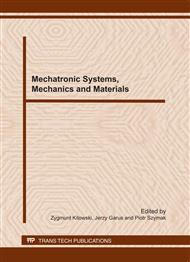[1]
J. Brix: Manoeuvering Technical Manual, Seehafen Verlag, Hamburg (1993).
Google Scholar
[2]
H.C. Chen, W.M. Lin, W.Y. Hwang: Application of Chimera RANS Method for Multiple-Ship Interactions in a Navigation Channel, Proc. of The Twelfth International Offshore and Polar Engineering Conference Kitakyushu, Japan, May 26–31 (2002).
Google Scholar
[3]
FLUENT Tutorial Guide, Fluent Inc., (2001)
Google Scholar
[4]
T.I. Fossen: Guidance And Control Of Ocean Vehicles, John Willey & Sons Ltd., Norway (2003).
Google Scholar
[5]
W. Gierusz: Simulation model of the shiphandling training boat "Blue Lady" Int.Conf. Control Application in Marine Systems, Glasgow, Scotland, " July (2001).
DOI: 10.1016/s1474-6670(17)35092-9
Google Scholar
[6]
W. Gierusz: Simulation model of training ship (in polish), Zeszyty Naukowe Wyższej Szkoły Morskiej w Gdyni, 37(1999), pp.5-16.
Google Scholar
[7]
L. Gucma, M. Schoeneich, J. Jachowski: CFD ship squat determination method validation by GPS–RTK measurements, Proc. of International Conference on Maritime Traffic Engineering, Poland (2007).
Google Scholar
[8]
K. McTaggart, D. Cumming, C. Hsiung, L. Li: Hydodynamic Interactions Between Ships During Underway Replenishment, Proc. of 6th Canadian Marine Hydrodynamics Structures Conference, Vancouver, May (2001)
Google Scholar
[9]
J.N. Newman: The Force and Moment on a slender body of revolution moving near a wall, David Taylor Basin, Washington D.C, Report No 2127 (1965)
DOI: 10.21236/ad0628161
Google Scholar
[10]
K.J. Rawson, E.C. Tupper: Basic Ship Theory, Buttrworth, Oxford (2001).
Google Scholar
[11]
D.W. Taylor: Some model experiments on suction of vessels, Transaction of the Society of Naval Architects and Marine Engineers, Vol. 17(1909), p.2–22.
Google Scholar
[12]
E.O. Tuck, and J.N. Newman: Hydrodynamic interations between ships, Proc. of the 10th Symposium on Naval Hydrodynamics, Cambridge, Mass, Office of Naval Research, Washington, (1974), pp.35-70.
Google Scholar
[13]
K.S. Varyani, A. Thavalingam, P. Krishnankutty: New generic mathematical model to predict hydrodynamic interaction effects for overtaking maneuvers in simulators, Journal of Marine Science and Technology, 9(2004), pp.24-31
DOI: 10.1007/s00773-003-0172-4
Google Scholar


